Mumrills
Mumrills was the site of the largest Roman fort on the Antonine Wall in Scotland.[3] It is possible that Mumrills could exchange signals with Flavian Gask Ridge forts.[4] Some believe Mumrills may have been the site of Wallace's defeat at the Battle of Falkirk.[5] The farm at Mumrills was also used as an early site for the Falkirk Relief Church.[6]
Excavations
Excavations, which took place in the years 1923-1928 and 1958-1960[7], established its outline.[8] Photographs of the excavations can be found online.[9]
Inscribed Stones
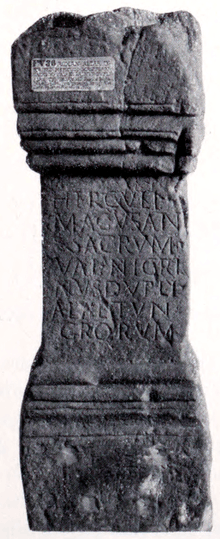
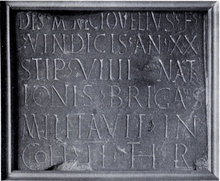
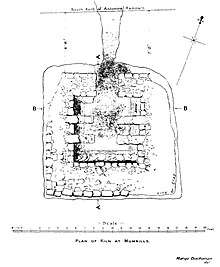

An altar to Hercules Magusanus[13] was found in 1841 "near the Bridge at Brightons" about a mile south-east of this fort. It is now in the National Museums Scotland.[14]
A second altar to the Matres (mother goddesses) was found at Mumrills. The altar was dedicated by Cassius, a signifer serving at the fort. The historian Alfred von Domaszewski had suggested that the "Matres" mentioned in the altar were actually the Campestres, another term for the Silvanae. [15] It was carved between 140 and 165 AD.[16]
A third inscribed stone has been described as a "Funerary inscription for Nectovelius". George Macdonald says the translation is: "To the Divine Manes. Nectovelius, son of Vindex. Aged thirty. A Brigantian by birth, he served for nine years in the Second Cohort of Thracians."[17] The Brigantes were a Celtic tribe who controlled the largest section of what would become Northern England. This shows local recruitment of native Britons.
Other Finds and Videos of Scans
A stone carving of Hercules was found in a back garden in the village of Laurieston, Falkirk in 1987.[18]
Other finds include a section of a palmate funerary monument,[19] a heavy, iron chisel[20], a set of wrought iron tongs,[21] a box flue tile,[22] a cooking pot of back burnished ware,[23] and a large piece of Roman concrete made out of crushed tile.[24]
Many Roman forts along the wall held garrisons of around 500 men.[25] Larger forts like Castlecary and Birrens had a nominal cohort of 1000 men[26] but probably sheltered women and children[27] as well although the troops were not allowed to marry.[28] There is likely too to have been large communities of civilians around the site.[29] Something of the soldiers' diet may be inferred from the variety of animal bones and shells found at the fort.[30] Other buildings have been found which might have supported smelly industries like tanning or smithing. A hearth was found which could have been used to support troops.[31]
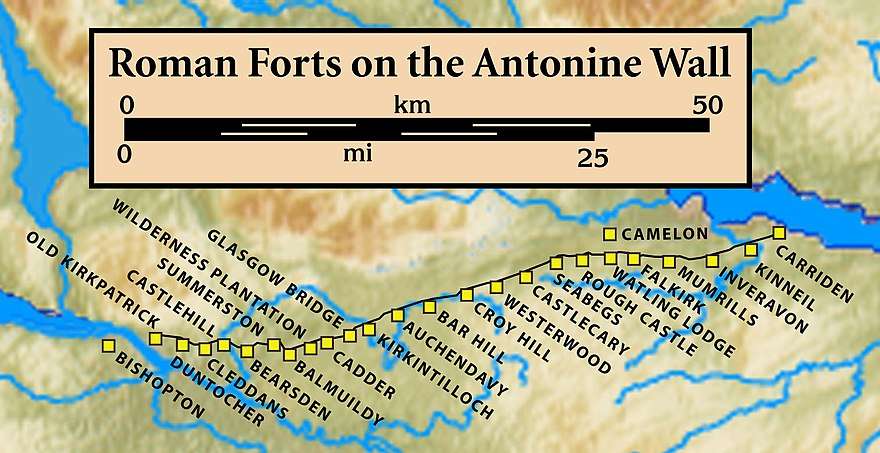
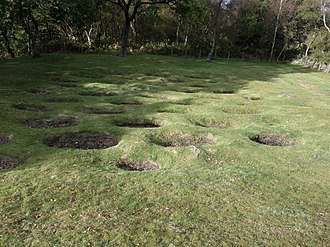
References
- ↑ "Site of the Mumrills Fort". Mumrills from zoomable OS map with opacity slider. Ordnance Survey. Retrieved 10 July 2018.
- ↑ "Open Street Map". Retrieved 18 November 2017.
- ↑ "Mumrills". CANMORE. Royal Commission on the Ancient and Historical Monuments of Scotland. Retrieved 2017-11-18.
- ↑ Woolliscroft, D. J. "Signalling and the design of the Gask Ridge system". Roman Gask Project. Retrieved 10 July 2018.
- ↑ Beers, Roy (8 July 2018). "Does a mystery site at Mumrills hold the answer to Falkirk's most tragic secret?". Falkirk Herald. Retrieved 10 July 2018.
- ↑ Scott, Ian (2 March 2018). "A new lease of life for Falkirk's West Church". Falkirk Herald. Retrieved 29 April 2018.
- ↑ Steer, K. A. "EXCAVATIONS AT MUMRILLS ROMAN FORT, 1958-60, Proceedings of the Society of Antiquaries of Scotland, 94: 86–132" (PDF). Retrieved 18 November 2017.
- ↑ "Mumrills". Frontiers of the Roman Empire (site by site). Retrieved 18 November 2017.
- ↑ "Mumrills". Scottish Places. Retrieved 18 November 2017.
- ↑ Macdonald, Sir George (1934). The Roman wall in Scotland, by Sir George Macdonald (2d ed., rev., enl., and in great part rewritten ed.). Oxford: The Clarendon press. pp. 417–418. Retrieved 11 October 2017.
- ↑ Macdonald, Sir George (1934). The Roman wall in Scotland, by Sir George Macdonald (2d ed., rev., enl., and in great part rewritten ed.). Oxford: The Clarendon press. pp. 435–436. Retrieved 11 October 2017.
- ↑ Macdonald, George (1915). Proceedings Of The Society Of Antiquaries Of Scotland 1914-1915 Vol.49. Edinburgh: Neill and Co. Ltd. pp. 93–138. Retrieved 18 November 2017.
- ↑ "RIB 2140. Altar dedicated to Hercules Magusanus". Roman Inscriptions of Britain. Retrieved 18 November 2017.
- ↑ "Altar from near Mumrills, Stirlingshire". NAMS. Retrieved 18 November 2017.
- ↑ "RIB 2141. Altar dedicated to the Mother Goddesses". Roman Inscriptions of Britain. Retrieved 18 November 2017.
- ↑ "Altar (piece) from Mumrills, Stirlingshire". NAMS. Retrieved 18 November 2017.
- ↑ MacDonald, George (1911). The Roman wall in Scotland (1st ed.). Glasgow: J. Maclehose. p. 352. Retrieved 29 April 2018.
- ↑ "Relief carving of Hercules, Laurieston". Retrieved 18 November 2017.
- ↑ "Section of a funerary monument, Mumrills". Retrieved 18 November 2017.
- ↑ "Chisel, Mumrills". Retrieved 18 November 2017.
- ↑ "Tongs, Mumrills". Retrieved 18 November 2017.
- ↑ "Box Flue Tile, Mumrills". Retrieved 18 November 2017.
- ↑ "Cooking Pot, Mumrills". Retrieved 18 November 2017.
- ↑ "Concrete flooring fragment, Mumrills". Retrieved 18 November 2017.
- ↑ "Soldier". Frontiers of the Roman Empire. Retrieved 21 October 2017.
- ↑ Miller, S. N. (1952). The Roman Occupation Of South Western Scotland Being Reports Of Excavations And Surveys Carried Out Under The Auspices Of The Glasgow Archaeological Society By John Clarke, J. M. Davidson, Anne S. Robertson, J. K. St. Joseph, Edited For The Society With An Historical Survey By S. N. Miller. Glasgow: Robert Maclehose & Company Limited. Retrieved 11 October 2017.
- ↑ "Children". Frontiers of the Roman Empire. Retrieved 21 October 2017.
- ↑ "Roman child's leather shoe". A History of the World. BBC. Retrieved 17 October 2017.
- ↑ Rohl, Darrell, Jesse. "More than a Roman Monument: A Place-centred Approach to the Long-term History and Archaeology of the Antonine Wall" (PDF). Durham Theses. Durham University. Available at Durham E-Theses Online ref: 9458. Retrieved 14 October 2017.
- ↑ "Mumrills Antonine Wall Fort & Camps". Roman Britain. Retrieved 29 April 2018.
- ↑ Smith, Samuel (1938–39). "3. AN INDETERMINATE STRUCTURE AND A HEARTH FOUND OUTSIDE THE ROMAN FORT AT MUMRILLS" (PDF). The Society of Antiquaries of Scotland. Volume 73: 319–324. Retrieved 30 April 2018.
- ↑ "Gruesome secret of Antonine wall Romans kept our ancestors in line with deadly 'lilies'". The Herald. 19 February 2004. Retrieved 28 April 2018.
